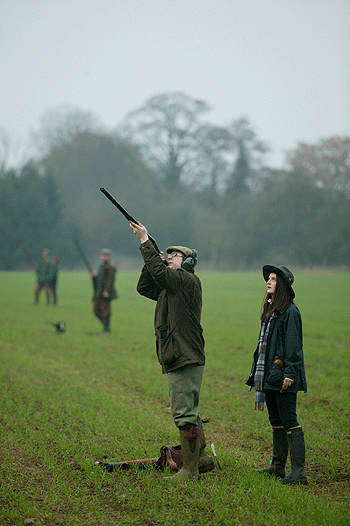Cubley Estate shoot

For a shooting man, what better way is there to celebrate your 60th birthday than by spending the day shooting with friends and family? Especially on your own shooting estate.
The Hon. David Legh was one such gentleman, and on a misty morning in November I joined him and his team on a mixed partridge and pheasant day on the Cubley estate, near Ashbourne in Derbyshire. The estate has been in the Legh family for 30 years and woodlands that they planted years ago are now presenting good birds. It must be very rewarding to see these measures bearing fruit as the years pass. In fact, the first drive, named Katherine?s Wood, was planted 20 years ago to celebrate the birth of David?s daughter.
The estate comprises 2,000 acres of mixed arable, pasture and woodland set in a rolling landscape. It is ideal ground for showing partridges and pheasants and home to a variety of wildlife and birds of prey. Like many others, the estate used to host a good wild grey partridge shoot and, in keeping with other estates, the headkeeper, Kim Robinson, has experimented with releasing grey partridges, as well as redlegs, since he started at Cubley 15 years ago.
Kim felt that starting pheasant shooting on 1 October was too early, so the partridges provide some days before the pheasant shooting gets into full swing. While some estates have found that releasing greys is pointless as the numbers dwindle, Kim has had some breeding success with released birds. In fact, he did have 25 breeding pairs, but this achievement was destroyed when the birds were wiped out one night during silage cutting. Kim is not a fan of this process, which can take place up to four times a year, and he feels it is injurious to many species of ground-nesting birds and mammals ? he can recallseeing lapwing chicks suffering particular harm.
As with many shoots, Kim found that the warm autumn and a tremendous acorn crop caused his birds to wander. Though dogging-in is an option, many of the hedges on the estate are so thick that it is hard to push the birds or a dog
through and may actually send the birds the wrong way, so, as Kim put it: ?we have to cross our fingers and do the best we can.?
Maize is a popular covercrop for its holding ability, in addition to providing cover from predators and allowing easy movement for the beaters. Kim also uses King?s Campaign mix, which comprises sorghum, millet and linseed. There is also a belt of artichokes on the estate that has withstood several attempts at ploughing.
The issue of what strains of pheasant to release will always be a subject of debate. Kim has tried all sorts of breeds and once favoured the strain known as the French common. He said: ?They are good fliers and make a good table bird, but we have had trouble with them straying. Some of the smaller breeds fly well, but are a bit on the thin side for roasting?. Kim currently uses a mixed variety, bought as day-olds from Cheshire Game, which he feels are the best so far. ?They hold well, fly well and are a good size,? he said.
On the day of the shoot, the beaters and pickers-up met in Kim?s yard, where, with a thunderous roar and a belch of smoke, an ex-army lorry burst into life to carry them off to the first drive. Despite David?s seemingly complex method for numbering the pegs on the estate, the Guns were well able to find their pegs, with David back-gunning. The mist showed no sign of thinning and birds broke to the right and left of us, but there was still plenty of action for all.
The wind was rising on the second drive, which Kim had been concerned about. A southerly wind on the estate is the worst possible scenario, and it was exacerbated by mist. A snipe ziz-zagged above, barely visible in the gloom, but coveys of redlegs and pheasants came over in good numbers. Kim was a little disappointed, as some greys he had put down went the opposite way, with the southerly being the culprit.
The shoot not only had a good beating team but a diverse range of pickers-up. The National Gamekeepers? Organisation?s Louise Stimson had a handful of canine helpers, including her 15-year-old deaf Labrador Honey. Equipped with a fine team of well-built Labs was A-panel judge Mick Newsam, who hoovered the fields with expected efficiency.
Also celebrating its 60th birthday was John and Sue Mead?s Land Rover Series I. ?It hasn?t been in the family since its manufacture,? said John, ?but I had always wanted one, and decided to bring it out for David?s birthday.? It was a lovely vehicle ? a little piece of history ? and if it could speak it would be fascinating to hear where it had been on its travels throughout its life.
On the Gorse drive, David pointed out some of the work that had been done to one of the woods. He said: ?All the birds used to go back on this drive, and the wood was largely scrub woodland and a good place to find a fox. We felled the rear half out of the wood and replanted it, and then did the same thing to the front half 10 years ago. Now it makes an excellent drive.? There were, indeed, some beauties that sailed over the line here.
With dusk not far off, the final drive died away in a smattering of shots. It had been a special day by anyone?s standards, and particularly for Kim and his partner Maureen after all their worrying about straying birds. They had, in fact, broken three records. The overall bag was the largest they had ever managed, and the two last drives, Big Wood and Accession, had also produced the shoot?s largest bags ever.








